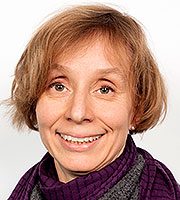When two worlds collide
7 Mar 2018 by Evoluted New Media
Last month the Deconstructing Patterns exhibition opened at the Francis Crick Institute in London aiming to fuse the worlds of art and science. We caught up with Dr Iris Salecker of the Visual Circuit Assembly Laboratory to find out what science can learn from art…
Tell us about the exhibition
In the exhibition “Deconstructing patterns: art and science in conversation”, researchers at the Francis Crick Institute were paired with artists using words, sound, sculpture, photography, light and film as their media of expression. The exhibition is subdivided into three zones exploring the theme of patterns, central to many scientists in our institute. My lab investigates the mechanisms how neural circuits assemble during development using the visual system of the fruit fly Drosophila as a model. In a perfect match, we collaborated with the visual artist Helen Pynor to cover the topic of “Transforming Connections” within the second zone. Helen’s artistic pieces are placed next to two science cases explaining our research that inspired her work. Mirroring Helen’s sculptural piece, movie clips and a series of images then draw the attention of visitors to the magical transformations, that the whole body and nerve cells in the visual system of the fruit fly undergo during development. The final section gives a glimpse into two ongoing projects in our lab and concludes by highlighting the importance of using Drosophila as a model organism in research.
When art and science are combined in this way - other than the beautiful results - can they tell us anything?
Absolutely. The idea is to raise curiosity. A beautiful and intriguing microscopic image or piece of art may invite visitors to stay on and to begin to ask questions about the background of both the scientific and artistic work. For instance, we can ask, why is it that we find something beautiful? How can we see and recognize elements in images? How do patterns emerge during development? Exploring the same topic, what does the artist see and what does the scientist see? Combined, this may give us unexpected insights and heighten our experience of the creative work of both.
Science and art are both trying to explain the world in some way; do you think the practice of the two forms can learn anything from each other?
To be able to see and understand visual art, we need our eyes and underlying neural circuits. Artists intuitively develop means that engage and direct the minds of viewers in figurative, abstract or metaphoric ways. Scientists can ask why and how our brains are able to do this. We can learn from each other and inspire each other to explore new questions and new ways of representation.
What was it like working with Helen for this process?
For my team and me, it was a very enriching experience to work with Helen during the last year. We had the opportunity to delve into each other’s world during the process. Helen set up her desk and at times her studio in our lab to gain hands-on experience in working with Drosophila, preparing samples, and taking images with the laser confocal microscope. In turn, we were invited to visit Helen’s studio to learn about her ideas. We spent many hours discussing, as Helen sought to understand our research in great depth for her sculptural piece. We became part of her art work ourselves through the filming of my hand gestures explaining the transformations taking place in the visual system. Finally, we also cooperated in scientific experiments filming different developmental stages in the life cycle of Drosophila. When we started the project, we did not really know, what the outcome would be. While we introduced Helen to our work, we stepped back allowing her to pick up the different threads and create her own work and story. We hope to stay in touch in the future.
Outreach has become very important within science; do you think residencies like this should become more widespread?
It is paramount for scientists to engage and communicate with the public. Science shapes so many aspects of our lives. Most people are curious about science and nature, and this curiosity needs nurturing. Education and knowledge do make our lives better and are key to finding solutions for the challenges we are facing now and in the future. Yet, so many people think that science is not accessible to them. Exploring topics in an equal partnership using the two languages of art and science is a powerful strategy to invite people into both worlds to gain new unexpected insights. So yes, residencies should be encouraged between artists and scientists, or other groupings, such as architects, economists, and more.
[box type="shadow" ]Deconstructing patterns: art and science in conversation is on at the Francis Crick Institute, 1 Midland Road, London, Wed 10:00 – 20:00, Thu-Sat 10:00 – 16:00[/box]
 Dr Iris Salecker is group leader of the Visual Circuit Assembly Laboratory at the Francis Crick Institute
Dr Iris Salecker is group leader of the Visual Circuit Assembly Laboratory at the Francis Crick Institute





